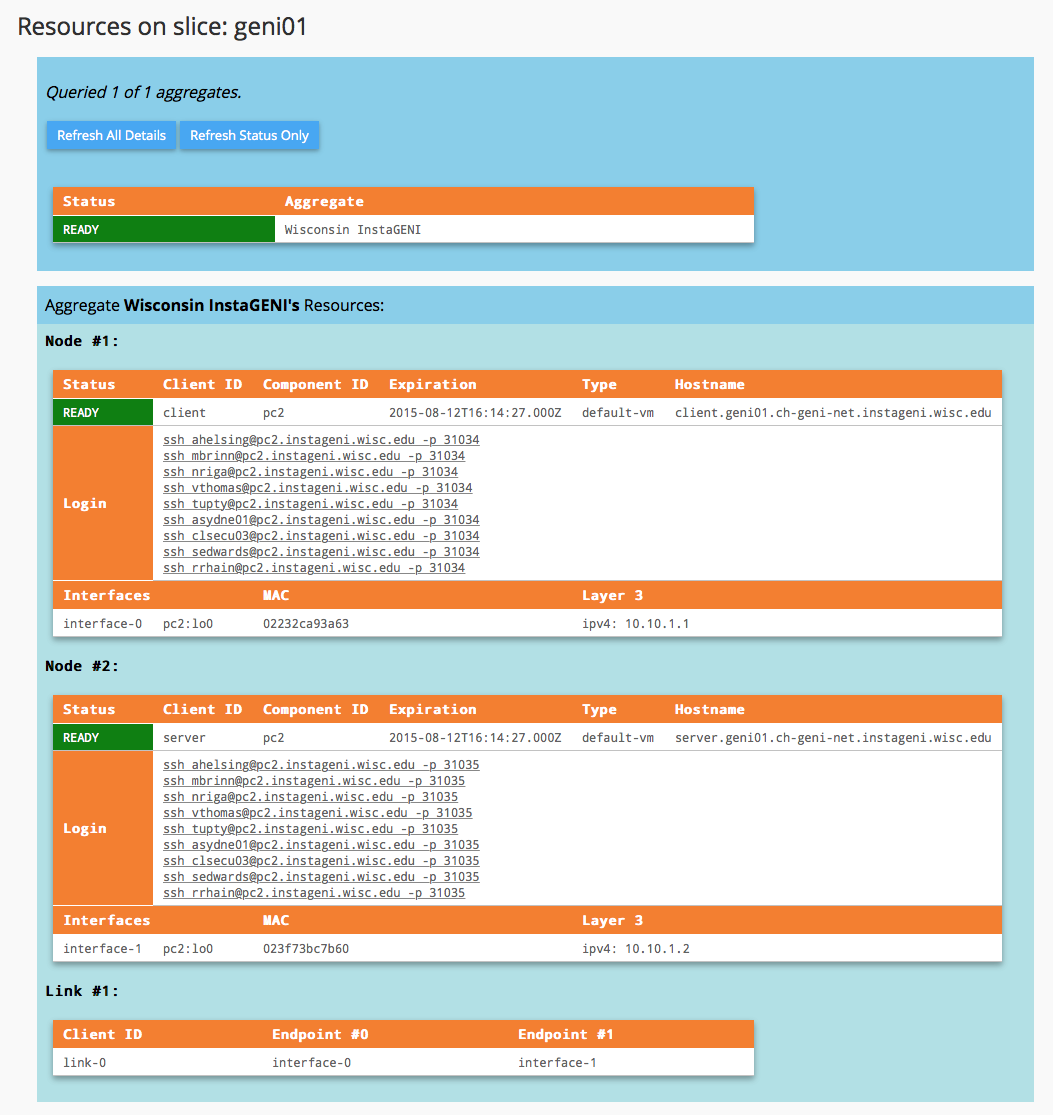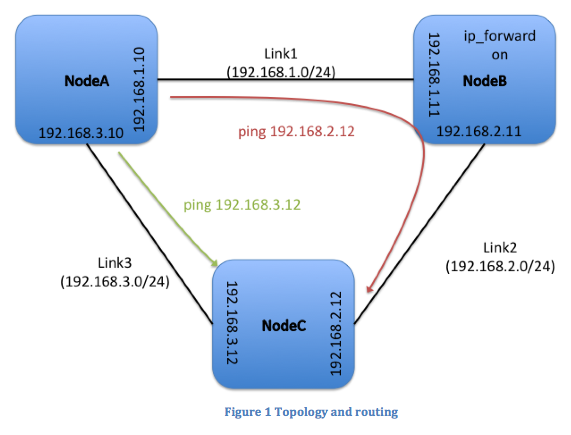| Version 19 (modified by , 9 years ago) (diff) |
|---|
Lab Zero: A First Experiment Using GENI

4. Configure and Initialize
Now that you have reserved your resources, you are ready to run your first GENI experiment.
4.1 Login to nodes
|

Figure 4-2 Login to a VM.
|
|
To ssh from the command line on unix-based machines, do the following (substitute the values shown on the screen):
ssh USERNAME@HOSTNAME |
|
|
To ssh from Windows machines, launch your favorite ssh client and substituting the values shown on the screen. |
5. Execute Experiment
5.1 Exercise A: Test Connectivity
5.1.1 Send IP traffic
The first simple experiment that we will run is to verify the IP connectivity between our hosts.
- Check the interfaces of your nodes. In the terminal type:
sudo ifconfig
You should see at least three interfaces:- A single control interface. This is the interface you use to access the node, e.g. ssh into your host. The control interface is mainly used for control traffic, i.e. traffic for controlling the node and the experiment.
- The data interfaces. These are the interfaces that are used for sending experimental traffic. These interfaces connect to the other hosts of your experiment through GENI. The links between these interfaces are the ones that allow you to run non-IP experiments. The data interfaces are the ones that have an IP address and mask that match what you configured before you reserved your resources.
- Fill in the worksheet, noting the name and IP address of the control and of the data interfaces for each node.

The command prompt on each node may say "NodeA", "NodeB", and "NodeC" respectively. - From NodeA,
pingthe adjacent NodeB data plane interface. From the terminal window that is logged in to the client type :ping <NodeB data IP addr> -c 5
For example:ping 192.168.2.11 -c 5
- Now,
pingthe NodeB control plane interface. From the terminal window that is logged in to NodeA type :ping <NodeB control IP addr> -c 5
For example:ping 172.17.1.9 -c 5
5.1.2 Install and use iperf
- Install the
iperfsoftware on both NodeA and NodeB:sudo apt-get install iperf hash
- Start an
iperfserver on NodeB:iperf -s
- From NodeA, run an
iperfclient via the data plane:iperf -c <NodeB data IP addr>
For example:iperf -c 192.168.2.11
What is the bandwidth of this link?
Why?
- On NodeA, run an
iperfclient via the control plane:iperf -c <NodeB control IP addr>
For example:iperf -c 172.17.2.2
What is the bandwidth of this link?
Why?
- Type
CTRL-Con NodeB to stop theiperfserver.
5.2 Exercise B: Configure Routing
In this experiment you will learn how to set up static routing with the route command.
|

Figure 5-1 Network Topology for the Experiment |
|
|
|
5.3 Exercise C: Explore the Data and Control Planes
5.3.1 Bring down one of NodeB's data interfaces
- ExoGENI nodes run a service called "neuca" that managed network interfaces on the node. To manually adjust the IP address, we must first disable neuca on both nodes.
sudo service neuca stop

The ExoGENI "neuca" service controls a variety of network configuration details. - From NodeA, start pinging one of NodeB's data plane interfaces:
ping <NodeB data IP addr>
- On NodeB, bring down the data plane interface
(being careful to disable the data interface NOT the control interface):
sudo ifconfig <NodeB data interface name> down
After you bring down the data interface, the pings should indicate that the destination is unreachable.
Why?
|
|
Be extra careful to disable the IP on the data interface, bringing down the IP on the control interface means that you will lose connectivity to your host. |
5.3.2 Bring down NodeB's control interface
- From NodeA, start pinging NodeB's control plane interface:
ping <NodeB control IP addr>
- From NodeB, bring down the control plane interface and try to ping it from NodeA:
sudo ifconfig <NodeB control interface name> down
Your ssh session should immediately hang.
Why?
After you bring down the control interface, the pings should indicate that the destination is unreachable. Why?
|
|
Unfortunately, in order to recover from a situation like this where you've lost the ability to login to your nodes, the only way to recover is to delete your resources and start again. |
6. Analyze Experiment
Now is when you would ordinarily analyze the results of your experiment.
6.1 Logout of your nodes
- Then type
exitin your open terminal.
Congratulations you have run an experiment in GENI!

